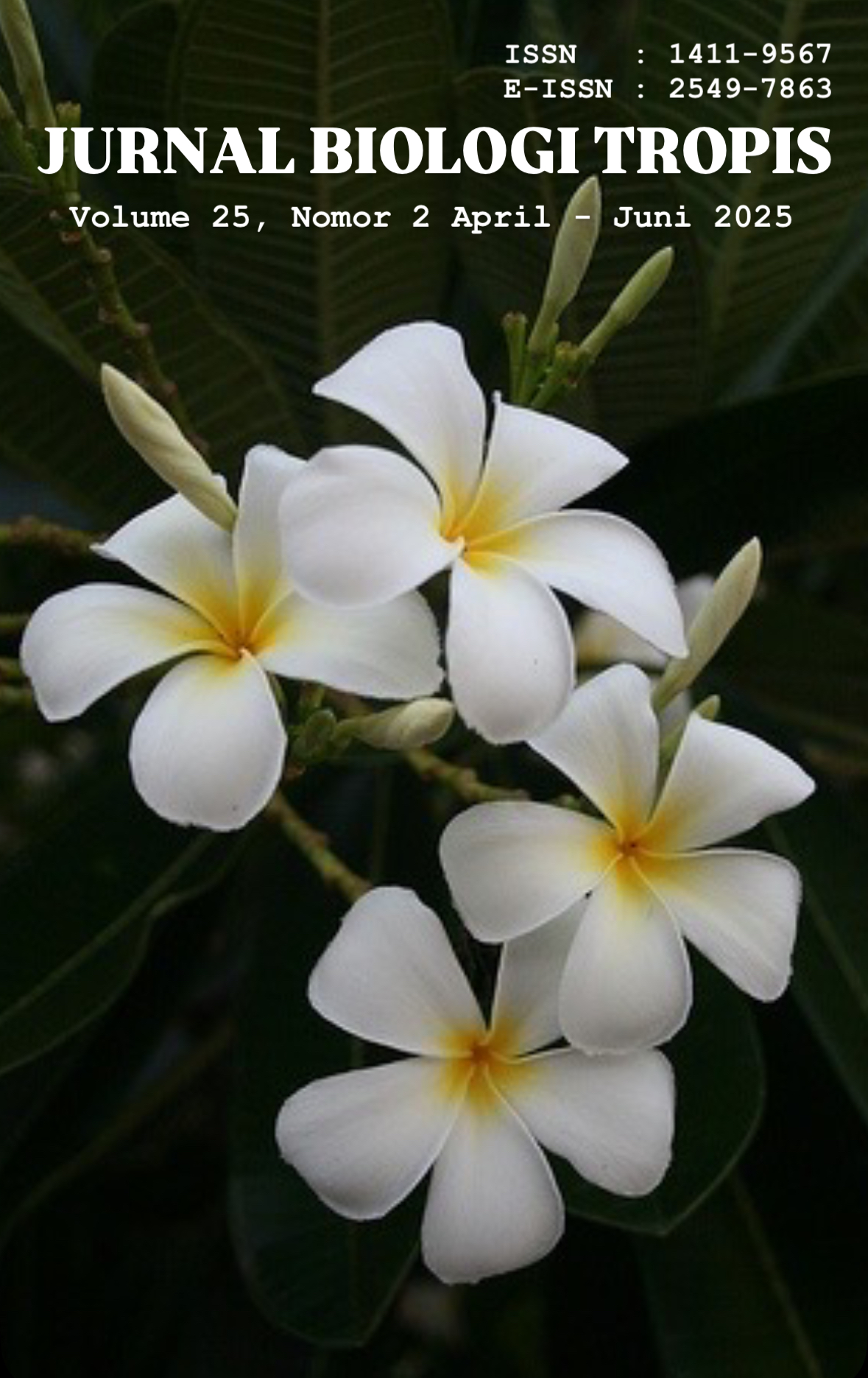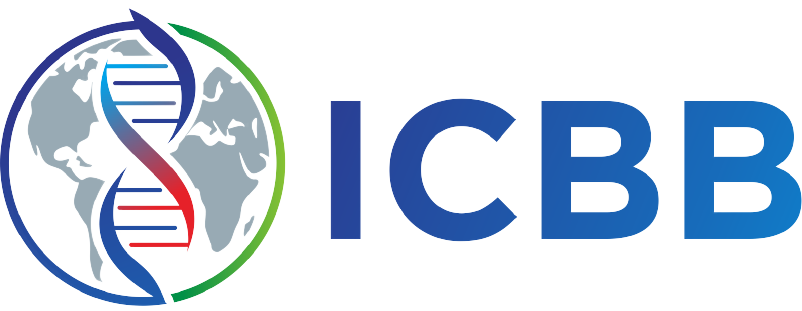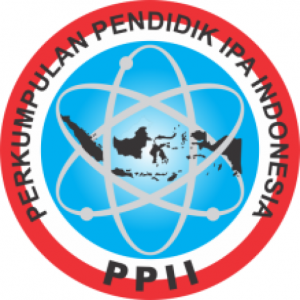Potential of Bioactive Compounds of Allium sativum L. var. solo garlic Extract in Inhibiting InhA Protein in Mycobacterium tuberculosis
Authors
Uun Rohmawati , Atikah AmaliaDOI:
10.29303/jbt.v25i2.9119Published:
2025-05-27Issue:
Vol. 25 No. 2 (2025): April-JuniKeywords:
Allium sativum L. var. solo garlic; bioactive compounds; InhA protein; Mycobacterium tuberculosis, molecular docking.Articles
Downloads
How to Cite
Downloads
Metrics
Abstract
Tuberculosis (TB) is caused by the bacteria Mycobacterium tuberculosis. In general, TB is treated with compounds that inhibit the work of one of the enzymes in the bacteria Mycobacterium tuberculosis, namely the InhA enzyme. One of the herbal plants that has the potential to inhibit the InhA protein in the bacteria Mycobacterium tuberculosis is. Allium sativum L. var. solo garlic. This research aims to determine the bioactive compounds in Allium sativum L. var. solo garlic in inhibiting the InhA protein in Mycobacterium tuberculosis which can be used as an alternative drug in the treatment of TB through an in silico approach. The method used in this study was qualitative phytochemical screening and GCMS test on Allium sativum L. var. solo garlic extract, the bioactive compounds found were tested in silico through a molecular docking approach. The research results obtained that Allium sativum L. var. solo garlic contains alkaloids, flavonoids, tannins and steroids. Based on the results of the GCMS test, the bioactive compounds that have an area of more than 5% are Heptadecene-(8)-Carbonic Acid-(1), 3-Deoxy-D-Mannonic Acid, 5-Hydroxymethylfurfural, Melezitose and Oleic acid. The results of molecular docking showed that the compound 3-Deoxy-D-mannonic acid had a binding affinity of -4.9, 5-Hydroxymethylfurfural -4.8, Oleic Acid -6.4, Nicotinamide-Adenine-Dinucleotide (Control) had a binding affinity of -11.4. Low binding affinity indicates that the compound can bind to the protein with little energy. The Gyps energy theory states that the smaller the energy produced from a bond between the ligand and its receptor, the more stable the bond is. The lowest binding energy to the InhA protein is in the control compound Nicotinamide-Adenine-Dinucleotide, Oleic Acid, 3-Deoxy-D-mannonic acid, 5-Hydroxymethylfurfural.
References
Alfauzi, R. A., Lilis Hartati, Danes Suhendra, Tri Puji Rahayu, & Hidayah, N. (2022). Ekstraksi Senyawa Bioaktif Kulit Jengkol (Archidendron jiringa) dengan Konsentrasi Pelarut Metanol Berbeda sebagai Pakan Tambahan Ternak Ruminansia: Extraction of Jengkol (Archidendron jiringa) Peel Bioactive Compounds with Different Concentrations of Methanol Solvents as Supplementary Feed for Ruminants. Jurnal Ilmu Nutrisi Dan Teknologi Pakan, 20(3), 95–103. https://doi.org/10.29244/jintp.20.3.95-103
Arliny, Y., Muarif, M. F., Mahdani, W., & Yanifitri, D. B. (2025). Anti-TB Drug Side-Effects on the Treatment of Drug-Resistant Tuberculosis (DR-TB) in dr. Zainoel Abidin Hospital Banda Aceh. Jurnal Respirologi Indonesia, 45(1), 21–29. https://doi.org/10.36497/jri.45i1.507
Bazaid, A. S., Aldarhami, A., Patel, M., Adnan, M., Hamdi, A., Snoussi, M., Qanash, H., Imam, M., Monjed, M. K., & Khateb, A. M. (2022). The Antimicrobial Effects of Saudi Sumra Honey against Drug Resistant Pathogens: Phytochemical Analysis, Antibiofilm, Anti-Quorum Sensing, and Antioxidant Activities. Pharmaceuticals, 15(10), 1212. https://doi.org/10.3390/ph15101212
Belete, T. M. (2022). Recent Progress in the Development of Novel Mycobacterium Cell Wall Inhibitor to Combat Drug-Resistant Tuberculosis. Microbiology Insights, 15, 11786361221099878. https://doi.org/10.1177/11786361221099878
Casuga, F. P., Castillo, A. L., & Corpuz, M. J.-A. T. (2016). GC–MS analysis of bioactive compounds present in different extracts of an endemic plant Broussonetia luzonica (Blanco) (Moraceae) leaves. Asian Pacific Journal of Tropical Biomedicine, 6(11), 957–961. https://doi.org/10.1016/j.apjtb.2016.08.015
Chen, D., Oezguen, N., Urvil, P., Ferguson, C., Dann, S. M., & Savidge, T. C. (2016). Regulation of protein-ligand binding affinity by hydrogen bond pairing. Science Advances, 2(3), e1501240. https://doi.org/10.1126/sciadv.1501240
Fahdhienie, F., Mudatsir, M., Abidin, T. F., & Nurjannah, N. (2024). Risk factors of pulmonary tuberculosis in Indonesia: A case-control study in a high disease prevalence region. Narra J, 4(2), e943. https://doi.org/10.52225/narra.v4i2.943
Fatima, S., & Dwivedi, V. P. (2020). Allicin as an Adjunct Immunotherapy against Tuberculosis. Journal of Cellular Immunology, 2(4). https://doi.org/10.33696/immunology.2.039
Ghazali, M., Zaki, M., & Hidayati, E. (2021). Antibacterial Activity of Methanol Extract of Sargassum polycystum on Escherichia coli and Staphylococcus aureus. Jurnal Biologi Tropis, 21(1), 199–205. https://doi.org/10.29303/jbt.v21i1.2485
Gräb, J., Suárez, I., Van Gumpel, E., Winter, S., Schreiber, F., Esser, A., Hölscher, C., Fritsch, M., Herb, M., Schramm, M., Wachsmuth, L., Pallasch, C., Pasparakis, M., Kashkar, H., & Rybniker, J. (2019). Corticosteroids inhibit Mycobacterium tuberculosis-induced necrotic host cell death by abrogating mitochondrial membrane permeability transition. Nature Communications, 10(1), 688. https://doi.org/10.1038/s41467-019-08405-9
Gupta, V., Tyagi, S., & Tripathi, R. (2023). Hexadecanoic acid methyl ester, a potent hepatoprotective compound in leaves of Pistia stratiotes L. The Applied Biology & Chemistry Journal, 4(4), 118–120. https://doi.org/10.52679/tabcj.2023.0012
Hartini, S., Sukarya, I. G. A., & Wasito, A. P. (2024). Comparative Analysis of Sharia and The Effects of Black Garlic (Black Allium sativum) on Creatinine Levels in Tuberculosis-Infected Mice (Mus Musculus). 6(3).
Hsieh, S.-C., Lu, C.-C., Horng, Y.-T., Soo, P.-C., Chang, Y.-L., Tsai, Y.-H., Lin, C.-S., & Lai, H.-C. (2007). The bacterial metabolite 2,3-butanediol ameliorates endotoxin-induced acute lung injury in rats. Microbes and Infection, 9(12–13), 1402–1409. https://doi.org/10.1016/j.micinf.2007.07.004
Indarto, T., Sukartini, T., & Makhfudli, M. (2020). Factors Contributing to TB at Primary Health Center in Sidoarjo—Indonesia. Jurnal Ners, 15(1Sp), 433–435. https://doi.org/10.20473/jn.v15i1Sp.19783
Indriaty, I., Djufri, D., Ginting, B., & Hasballah, K. (2023). Phytochemical screening, phenolic and flavonoid content, and antioxidant activity of Rhizophoraceae methanol extracts from Langsa, Aceh, Indonesia. Biodiversitas Journal of Biological Diversity, 24(5). https://doi.org/10.13057/biodiv/d240541
Judžentienė, A., Pečiulytė, D., & Nedveckytė, I. (2024). In Situ Antimicrobial Properties of Sabinene Hydrate, a Secondary Plant Metabolite. Molecules, 29(17), 4252. https://doi.org/10.3390/molecules29174252
Kaczmarek, B. (2020). Tannic Acid with Antiviral and Antibacterial Activity as A Promising Component of Biomaterials—A Minireview. Materials, 13(14), 3224. https://doi.org/10.3390/ma13143224
Karou, D., Savadogo, A., Canini, A., Yameogo, S., Montesano, C., Simpore, J., Colizzi, V., & Traore, A. S. (2005). Antibacterial activity of alkaloids from Sida acuta. 4(12), 1452–1457.
Koklesova, L., Liskova, A., Samec, M., Zhai, K., AL-Ishaq, R. K., Bugos, O., Šudomová, M., Biringer, K., Pec, M., Adamkov, M., Hassan, S. T. S., Saso, L., Giordano, F. A., Büsselberg, D., Kubatka, P., & Golubnitschaja, O. (2021). Protective Effects of Flavonoids Against Mitochondriopathies and Associated Pathologies: Focus on the Predictive Approach and Personalized Prevention. International Journal of Molecular Sciences, 22(16), 8649. https://doi.org/10.3390/ijms22168649
Kumar, N., Gusain, A., Kumar, J., Singh, R., & Hota, P. K. (2021). Anti-oxidation properties of 2-substituted furan derivatives: A mechanistic study. Journal of Luminescence, 230, 117725. https://doi.org/10.1016/j.jlumin.2020.117725
Lee, J.-E., Jayakody, J., Kim, J.-I., Jeong, J.-W., Choi, K.-M., Kim, T.-S., Seo, C., Azimi, I., Hyun, J., & Ryu, B. (2024). The Influence of Solvent Choice on the Extraction of Bioactive Compounds from Asteraceae: A Comparative Review. Foods, 13(19), 3151. https://doi.org/10.3390/foods13193151
Mardiyah, S. (2018). Efektivitas Anti Bakteri Perasan Bawang Putih (Allium sativum L.) terhadap Pertumbuhan Staphylococcus aureus. Medicra (Journal of Medical Laboratory Science/Technology), 1(2), 44–53. https://doi.org/10.21070/medicra.v1i2.1532
Masyudi, M., Hanafiah, M., Rinidar, R., Usman, S., & Marlina, M. (2022). Phytochemical screening and GC-MS analysis of bioactive compounds of Blumea balsamifera leaf extracts from South Aceh, Indonesia. Biodiversitas Journal of Biological Diversity, 23(3). https://doi.org/10.13057/biodiv/d230319
Morris, C. J., & Corte, D. D. (2021). Using molecular docking and molecular dynamics to investigate protein-ligand interactions. Modern Physics Letters B, 35(08), 2130002. https://doi.org/10.1142/S0217984921300027
Nawaz, H., Shad, M. A., Rehman, N., Andaleeb, H., & Ullah, N. (2020). Effect of solvent polarity on extraction yield and antioxidant properties of phytochemicals from bean (Phaseolus vulgaris) seeds. Brazilian Journal of Pharmaceutical Sciences, 56, e17129. https://doi.org/10.1590/s2175-97902019000417129
Ningrat, A. W. S. (2022). Docking Molekuler Senyawa Brazilein Herba Caesalpina Sappanis Lignum Pada Mycobacterium Tuberculosis Inha Sebagai Antituberkulosis. INHEALTH : INDONESIAN HEALTH JOURNAL, 1(1), 29–34. https://doi.org/10.56314/inhealth.v1i1.19
Ouriagli, T., Amnay, A., M. Raoui, S., & Faouzi Errachidi. (2023). Alkaloids from Marrubium vulgare L.: Antioxidant and Anti-Inflammatory Activities as a Function of Extraction Methods. Tropical Journal of Natural Product Research, 7(7). https://doi.org/10.26538/tjnpr/v7i7.20
Pantsar, T., & Poso, A. (2018). Binding Affinity via Docking: Fact and Fiction. Molecules, 23(8), 1899. https://doi.org/10.3390/molecules23081899
Patil, R., Das, S., Stanley, A., Yadav, L., Sudhakar, A., & Varma, A. K. (2010). Optimized Hydrophobic Interactions and Hydrogen Bonding at the Target-Ligand Interface Leads the Pathways of Drug-Designing. PLoS ONE, 5(8), e12029. https://doi.org/10.1371/journal.pone.0012029
Pushparaj Selvadoss, P., Nellore, J., Balaraman Ravindrran, M., Sekar, U., & Tippabathani, J. (2018). Enhancement of antimicrobial activity by liposomal oleic acid-loaded antibiotics for the treatment of multidrug-resistant Pseudomonas aeruginosa. Artificial Cells, Nanomedicine, and Biotechnology, 46(2), 268–273. https://doi.org/10.1080/21691401.2017.1307209
Rabaan, A. A., Alhumaid, S., Albayat, H., Alsaeed, M., Alofi, F. S., Al-Howaidi, M. H., Turkistani, S. A., Alhajri, S. M., Alahmed, H. E., Alzahrani, A. B., Mashraqi, M. M., Alwarthan, S., Alhajri, M., Alshahrani, F. S., Almuthree, S. A., Alsubki, R. A., Abuzaid, A. A., Alfaresi, M., Al Fares, M. A., & Mutair, A. A. (2022). Promising Antimycobacterial Activities of Flavonoids against Mycobacterium sp. Drug Targets: A Comprehensive Review. Molecules, 27(16), 5335. https://doi.org/10.3390/molecules27165335
Rana, K. M., Maowa, J., Alam, A., Dey, S., Hosen, A., Hasan, I., Fujii, Y., Ozeki, Y., & Kawsar, S. M. A. (2021). In silico DFT study, molecular docking, and ADMET predictions of cytidine analogs with antimicrobial and anticancer properties. In Silico Pharmacology, 9(1), 42. https://doi.org/10.1007/s40203-021-00102-0
Rante Pakadang, S., Hilaria, M., Rosmala Dewi, S. T., Sinala, S., & Jumain J, J. (2021). MIC and MKC Analysis of Herbal Medicine in Indonesia Against Mycobacterium tuberculosis. Pharmacognosy Journal, 13(5), 1058–1064. https://doi.org/10.5530/pj.2021.13.137
Retno Wardani, H., Widyarani, D., Agustin Wulandari, R., & Wicaksi, D. (2020). Potential of Herbal Plants Against Mycobacterium Tuberculosis Infection. D’Nursing and Health Journal (DNHJ), 1(2), 44–54. https://doi.org/10.36835/dnursing.v1i2.41
Saputri, D. S., & Putri, Y. E. (2020). IDENTIFIKASI SENYAWA BIOAKTIF MADU DI BEBERAPA DAERAH SUMBAWA DENGAN MENGGUNAKAN GAS CHROMATOGRAPHY. 1(1), 27–32.
Sayyah, M., Hadidi, N., & Kamalinejad, M. (2004). Analgesic and anti-inflammatory activity of Lactuca sativa seed extract in rats. Journal of Ethnopharmacology, 92(2–3), 325–329. https://doi.org/10.1016/j.jep.2004.03.016
Shaaban, M. T., Ghaly, M. F., & Fahmi, S. M. (2021). Antibacterial activities of hexadecanoic acid methyl ester and green‐synthesized silver nanoparticles against multidrug‐resistant bacteria. Journal of Basic Microbiology, 61(6), 557–568. https://doi.org/10.1002/jobm.202100061
Sharghi, M., Aminzadeh, Z., Ashtary-Larky, D., Firoozbakht, M., Mohamadpour, B., & Asadi-Samani, M. (1017). THERAPEUTIC EFFECTS OF HERBS ON MYCOBACTERIUM TUBERCULOSIS: A SYSTEMATIC REVIEW. 2(4), 627–640. https://doi.org/10.22301/IJHMCR.2528-3189.627
Singh, A. S., Singh, A., Vellapandian, C., Ramaswamy, R., & Thirumal, M. (2023). GC–MS Based Metabolite profiling, Antioxidant and Antiurolithiatic Properties of Apple Cider Vinegar. Future Science OA, 9(4), FSO855. https://doi.org/10.2144/fsoa-2023-0035
Stanzione, F., Giangreco, I., & Cole, J. C. (2021). Use of molecular docking computational tools in drug discovery. In Progress in Medicinal Chemistry (Vol. 60, pp. 273–343). Elsevier. https://doi.org/10.1016/bs.pmch.2021.01.004
Sun, Z., Xu, M., Wang, Y., & Hu, X. (2020). Synthetic Progress of Alkaloids against Mycobacterium Tuberculosis: Pseudopteroxazole and Ileabethoxazole. Chinese Journal of Organic Chemistry, 40(12), 4203. https://doi.org/10.6023/cjoc202005034
Tyagi, T., & Agarwal, M. (2017). Phytochemical screening and GC-MS analysis of bioactive constituents in the ethanolic extract of Pistia stratiotes L. and Eichhornia crassipes (Mart.) solms. 6(1), 195–206.
Wahid, W. W. C., Arsy, F. F., Setiawati, N., Vicri, R. N., Viola, A., Lestari, B. W., & Aprillia, K. R. (2023). Increasing Financing for Tuberculosis Programs in Indonesia.
Wasilah, S., Sari, A. N., Nasution, R. S., & Diningrat, D. S. (2021). Anti-meningitis agent potentially of Syzigium Cumini Essential oil by GC-MS. IOP Conference Series: Earth and Environmental Science, 753(1), 012051. https://doi.org/10.1088/1755-1315/753/1/012051
Yazıcı, A. (2024). The Strain-Dependent Antimicrobial and Antibiofilm effect of Cis and Trans-Vaccenic Acid against Pseudomonas Aeruginosa. Cumhuriyet Science Journal, 45(1), 1–7. https://doi.org/10.17776/csj.1341700
Yu, X., Zhao, M., Liu, F., Zeng, S., & Hu, J. (2013). Identification of 2,3-dihydro-3,5-dihydroxy-6-methyl-4H-pyran-4-one as a strong antioxidant in glucose–histidine Maillard reaction products. Food Research International, 51(1), 397–403. https://doi.org/10.1016/j.foodres.2012.12.044
Zhou, Q., Wu, Z., Cheng, X., Zuo, Z., & Fan, C. (2024). Exploring Melezitose as a Potential Therapeutic Agent in Lung Cancer: Inhibitory Effects on Cell Proliferation and EMT-Mediated Signaling in A549 Cells. Pharmacognosy Magazine, 20(4), 1286–1294. https://doi.org/10.1177/09731296241251545
License
Copyright (c) 2025 Uun Rohmawati, Atikah Amalia

This work is licensed under a Creative Commons Attribution 4.0 International License.

Jurnal Biologi Tropis is licensed under a Creative Commons Attribution 4.0 International License.
The copyright of the received article shall be assigned to the author as the owner of the paper. The intended copyright includes the right to publish the article in various forms (including reprints). The journal maintains the publishing rights to the published articles.
Authors are permitted to disseminate published articles by sharing the link/DOI of the article at the journal. Authors are allowed to use their articles for any legal purposes deemed necessary without written permission from the journal with an acknowledgment of initial publication to this journal.


























